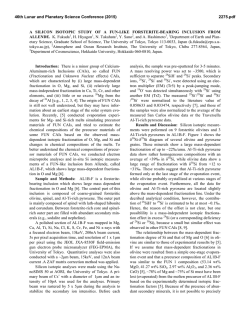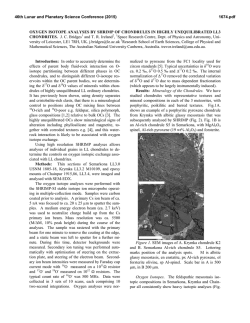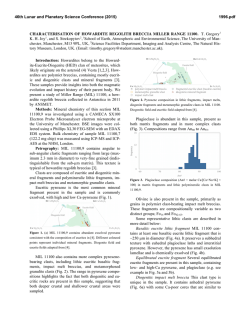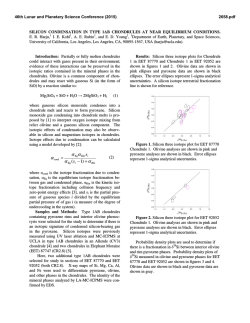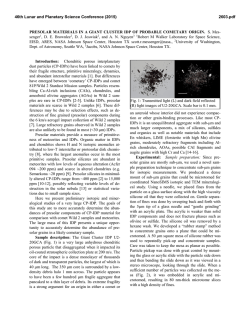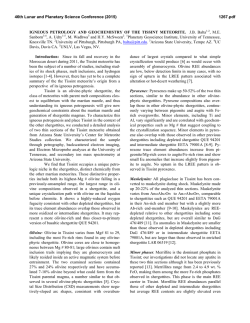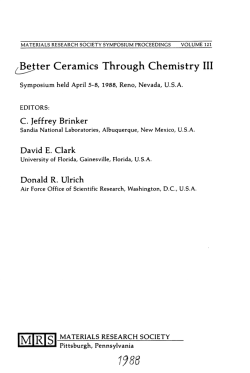
CRYSTALLIZATION CONTROL ON O ISOTOPES IN PYROXENE
46th Lunar and Planetary Science Conference (2015) 2684.pdf CRYSTALLIZATION CONTROL ON O ISOTOPES IN PYROXENE FROM A TYPE B1 CA-AL-RICH INCLUSION. J. Aléon1,2 , 1CSNSM, Bat 104, 91405 Orsay Campus, France, 2IMPMC, MNHN 61 rue Buffon 75005 Paris, France ([email protected]). Introduction: The origin of the O isotopic dichotomy between the 16O-rich Sun and the 16O-poor planets is still not understood. Ca-Al-rich inclusions (CAIs), the oldest solar system rocks, are possibly the best samples to investigate the astrophysical origin of the anomaly since their O isotopic composition spans the whole range between solar and planetary compositions. However their O isotopic record is related to their complex thermal history. The understanding of the mineral control on the O isotopic composition of igneous type B inclusions is still an unresolved question since no model has yet successfully explained the simultaneous presence of 16O-rich spinel, 16O poor melilite and anorthite and 16O-rich pyroxene. The 16Oenrichment in pyroxene notably remains a major problem to understand the isotopic evolution of type B CAIs. I report here a systematic study of O isotopes as a function of mineralogical properties of pyroxene in a fragment of the interior of USNM-3529-Z (courtesy of M. Maurette), an archetypal type B1 CAI from the Allende meteorite [1]. Sample and analytical method: The fragment was mounted as a polished section and characterized for mineralogy and petrography using the SX5 electron probe at the CAMPARIS facility in Paris. X-ray maps were notably acquired to study the petrographic context and chemical zoning of pyroxene and melilite. O isotopes were measured primarily in pyroxene (px) but also in melilite (mel) and to a lesser extent in anorthite (an), spinel (sp) and secondary alteration (alt) with the IMS1280 of the national facility at CRPG, Nancy. Measurements were done in multicollection mode using a large primary Cs+ beam of ~ 30 µm and using two Faraday cups (FC) for 16O and 18O and the axial electron multiplier (EM) for 17O. EM drift due to intense 17O signal and FC background on 18O were corrected by linear interpolation and regular measurements of standards. The instrumental mass fractionation was corrected using San Carlos olivine and JV1 diopside, using both Au and C coated mounts. Results: Melilite and pyroxene petrography : Mel is present as sub-mm tabular crystals with Åk content between 21 and 29 mol% overgrown by Mg-rich mel ranging from Åk40 up to Åk69. The sharp chemical contrast, the presence of embayments and fingers of Mg-rich mel inside the tabular crystals as well as the smaller sp size inside the latter suggest that they are relict from an early stage of crystallization. Px grains occur with classical type B CAI habitus [2] as (1) large sub-mm blocky crystals (Fig. 1), (2) small anhedral crystals poikilitically enclosed in mel and (3) partial or complete rims around sp enclosed in mel. Blocky crystals are systematically associated with Mg-rich mel overgrowth. Sp poikilitically enclosed in px tend to be larger that those in Al-rich melilite. Electron probe analyses yield total Ti content (calculated as TiO2tot) between 4.7 and 11.7 wt% in blocky crystals and between 2.5 and 9.6 wt% in other occurences. Al2O3 range from 16.1 to 21.9 wt% in blocky crystals and between 17.8 and 22.4 wt% in other occurences. Blocky crystals tend to have higher TiO2 and lower Al2O3 for similar MgO content than the other occurences. Overall, the mineral chemistry is typical of px in the interior of type B1 inclusions [2]. In addition, most blocky crystals show sector zoning, also classically observed in type B CAIs [1,2]. Both the mineral chemistry and sector zoning indicate that blocky px crystals crystallized from a melt. O isotopes: The O isotopic composition of all minerals (Fig. 2) is typical of type B CAIs and agrees well with previous data on 3529-Z [3]. All data plot along the CCAM line, with the possible exception of anorthite, which may be due to imperfect matrix effect correction. Sp is 16O-rich with ∆17O between -21.0‰ and -24.6‰. Mel is roughly homogeneous in isotopic composition with ∆17O between -3.5‰ and -1.9‰, all data within 2 standard deviations of the average. Secondary alteration phases have 16O-poor values that compare well with mel (-3.0‰ ≤ ∆17O ≤ -1.2‰). An is 16Odepleted but is slightly more 16O-rich than mel and alt (-6.5‰ ≤ ∆17O ≤ -4.5‰). Most px data compare well with previous data and cluster near the values of sp but 16O-depleted px is also found. ∆17O in blocky px range from -24.4‰ up to 14.9‰. Within single crystals, the O isotopic composition varies with crystallization indexes: TiO2tot and/or location relative to crystal cores as indicated by sector zoning. High TiO2tot and crystal cores are 16O-depleted with analyses that yield ∆17O > -19‰ being located next to crystal cores (with one possible exception in the high Ti grain Px6). Below 8 wt% TiO2tot, px is 16Orich with ∆17O ≤ -21‰ (Fig. 3). Due to the large beam size it has not been possible to measure directly small interstititial px crystals. One analysis with about half px - half mel yield an intermediate ∆17O value of 12.7‰. Adjacent mel has a ∆17O value of -3.1‰, indicating that px has ∆17O ≤ -22‰. With a corresponding TiO2tot of 6.1 wt%, it is comparable to blocky px. 46th Lunar and Planetary Science Conference (2015) References: [1] Podosek F. A. et al. (1991) GCA, 55, 1083–1110. [2] Simon S. B. et al. (1991) GCA, 55, 26352655. [3] McKeegan K. D. and Leshin L. A. (2001) in. Stable Isotope Geochemistry, Rev. Mineral. Geochem. 43, J. W. Valley and D. R. Cole (eds.), 279‐318. [4] Simon S. B. et al. (2007) GCA, 71, 3098-3118. [5] Dyl K. A. et al. (2011) GCA, 75, 937-949. [6] Lyons J. R. and Young E. D. (2005) Nature, 435, 317-320. [7] Yurimoto H. and Kuramoto K. (2004) Science, 305, 1763-1766. [8] Thiemens M. H. (2006) AREPS, 34, 217-262. Fig.1. Zoning of Px5 shown by a false color composite TiO2+MgO image. Bright yellow to dark purple: px with decreasing Ti; grey: mel; black: sp. Ellipses : SIMS analyses. Scale bar: 200 µm. 10 0 -10 !17O (‰) -20 -30 -40 -50 -60 -60 -50 -40 -30 -20 -10 0 10 20 !18O (‰) Fig 1. O isotopes in 3529-Z. mel: red; an: pink; alt: orange; sp: dark blue; px: light blue. !&%$ -.&$ -."$ -.%$ -.*$ -.#$ -.+$ -./$ -.0$ -.1$ !&#$ !"#$%&'(% Discussion: The relationship between O isotopes and both crystal chemistry and location within crystals indicates that the O isotopic composition of px evolved during crystallization from a partial melt. However contrary to previous assumptions, px did not crystallize from an initially 16O-rich melt. Because O selfdiffusion is very slow in pyroxene but rapid in CMAS melts, px must have crystallized from an initially 16Opoor melt that equilibrated with a 16O-rich ambiant gas. Grains adjacent to each other fall on similar ∆17OTiO2tot trends suggesting crystallization from connected melt pockets that equilibrated simultaneously. Line profiles extracted from TiO2tot maps in grain PxA and two sectors of Px2, in which 16O-poor px has been found, show that the TiO2tot content decreases linearly with distance from core. By contrast ∆17O drops rapidly in the Ti-rich central portion of the px grains down to sp-like 16O-excesses. This suggests that the melt from which px grew initially had an even more 16O-poor composition but equilibrated rapidly with a 16O-rich gas so that growth continued in an almost completely equilibrated 16O-rich melt. A possible source for such a 16O-poor melt is partial remelting of the 16O-poor least refractory mel. The 16O-rich composition of sp indicates that the precursor of 3529-Z first formed and was partially molten in a 16O-rich gas. It underwent subsequently partial melting and crystallization in a 16O-poor gas. The partial dissolution of large mel crystals probably initially 16O-rich resulted in much smaller diffusion domains in mel relicts thus allowing a relatively homogeneous 16O-poor composition. The last partial melting event took place in a 16O-rich gas and resulted in crystallization of pyroxene. This last 16O-rich environment may have been similar to that where Wark Lovering rims formed, although discussions on the redox state of WLR px prevent a firm conclusion [4,5]. Conclusion: Because 3529-Z is a typical type B1 CAI with close-to-canonical 26Al/27Al ratio [1], the crystallization of px in a 16O-rich gas after 16Odepletion of mel implies that both O reservoirs coexisted at the onset of solar system formation. This implies first that the 16O-depletion did not occur late in the outer protoplanetary disk [6]. In addition, the present data indicate that the CAI cooled in a 16O-rich environment at the end of CAI formation in agreement with observations in WLR and accretionary rims, which suggests that the disk may not have been 16Opoor due to self-shielding in the parent molecular cloud [7]. Non-mass dependant fractionation [e.g. 8] by a chemical reaction in the disk is a possible better candidate but the astrochemical mechanism and site responsible for the 16O-depletion in CAIs remain to be firmly identified. 2684.pdf !&($ !&'$ !"&$ !"%$ !"#$ )$ "$ *$ +$ ,$ &)$ &"$ )*$+,-,%&.,/(% Fig 2. ∆17O vs TiO2 in 9 different blocky px crystals from 3529-Z. Error bars correspond to 2 σ errors.
© Copyright 2026
